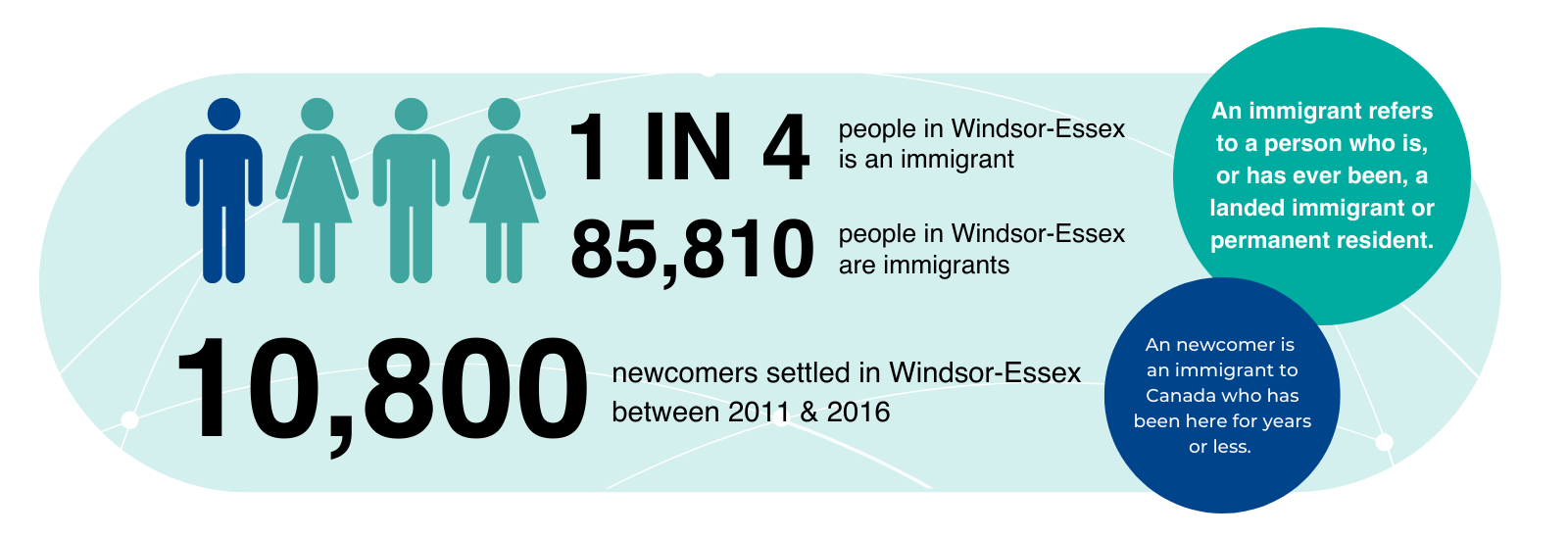As of 2016, almost one in three trade certificate holders were aged 55 or older, likely nearing retirement. BuildForce Canada also notes that the Ontario construction industry will need over 100,000 additional workers to fill retirement gaps and growth in the industry. As many newcomers have relevant experience when they arrive in Canada, with a recent Workforce WindsorEssex survey noting 15% of responding newcomers had skilled trades experience, they are a great fit to fill the talent pool for local employers.
With apprenticeship registrations and completions remaining stagnant and low over the last few years in Windsor-Essex, more needs to be done to ensure that those interested in working in the trades are encouraged and supported to do so. With both a skills shortage and high newcomer unemployment rates, there are likely disconnects between newcomer jobseekers, employment support staff, and employers looking to hire. Identifying where there are disconnects, and how they can be resolved, will ensure that newcomers have opportunities for meaningful employment in the trades and are able to use past skills and work experience as well.
Over numerous consultations with employers in the skilled trades, it is clear that solutions for the low supply of skilled trades people are needed. This report will address the challenges and present opportunities to overcome these challenges faced by employers, newcomers with skilled trades experience and interest in the skilled trades, and the service providers who serve as intermediaries to facilitate these connections.
Download the Full Report:
Highlights:
Immigration in Windsor-Essex
Windsor-Essex has been fortunate enough to attract more than 2,500 immigrants per year on average over the past decade, allowing the region’s labour market to benefit more than many other mid-sized centres in Canada. It is important to note that there may have been a dip in immigration numbers due to pandemic border closures, but immigration is expected to return to previously seen numbers over the next few years. Nearly 40% of workers in the Transportation and Warehousing sector are immigrants and 30% of all workers in the region’s professional, scientific and technical services were not born in Canada. This is great news for the region and for the skilled trades specifically as we continue to face a growing talent shortage.

Newcomers in the Skilled Trades
Many newcomers to Canada are excited for a chance at a second start in life. This excitement quickly dissipates as they face many barriers to leveraging their skills and previous experience into starting their careers here. These barriers include:
 Unclear processes for next steps: There is no central system for all newcomers to access to support them in figuring out their next career steps. While there are many non-profit organizations that provide these services, not all newcomers are directed to these services or are aware these services exist. This further complicates and adds stress to newcomers trying to acclimate to a new culture, language, and labour market.
Unclear processes for next steps: There is no central system for all newcomers to access to support them in figuring out their next career steps. While there are many non-profit organizations that provide these services, not all newcomers are directed to these services or are aware these services exist. This further complicates and adds stress to newcomers trying to acclimate to a new culture, language, and labour market.

Language: Language was the number one cited barrier for employment by newcomers, employers, and service providers. Training in a different language and learning to communicate with co-workers and management in that language is a daunting task. The lack of skilled trades training in languages other than English creates a limitation for those looking to begin their training while learning English concurrently.

Transportation: Many newcomers surveyed indicated a reliance on public transportation. The region’s already lacking transportation system does not offer routes to the industrial areas where many of the skilled trades jobs are located. The “Transit Master Plan” of 2019 aimed to address issues by extending hours of service for transit, growing the fleet and expanding the garage, and implementing the new route structure and network. This plan has yet to be implemented to rejuvenate and expand the city’s transit system.

Lack of certifications: The certification process for those with previous experience is far too lengthy. For those newcomers with skilled trades experience, it is a difficult process of language training, applying for apprenticeships, and testing in a new language. While a non-newcomer’s route to a journeyperson would follow the path of finding a sponsor, completing their training, and writing their exam. For newcomers, this path is not as direct.

Difficulty in Document Procurement: There are many reasons why newcomers with skilled trades experience from their home countries do not have the documentation Skilled Trades Ontario requires for certification for a tradesperson. Not all countries have divided their skilled trades into highly specialized categories like Canada has. In fact, most countries that newcomers are coming from organize their skilled trades into broader categories, further adding to the confusion faced by newcomers when trying to navigate their careers in Canada.

Lack of Canadian work experience and references: The initial barrier of language creates an added challenge of not being able to gain Canadian work experience or references. This may be due to implicit biases that those who cannot speak fluent English are not capable. It can potentially create a perpetual cycle of rejection of newcomers who cannot find the work experience to start their careers in the skilled trades.

Cultural taboos of skilled trade work: For both immigrants and non-immigrants, the skilled trades are often thought of as a career of last resort. This is in part due to the emphasis most societies have on other licensed professions such as lawyers and doctors, and partly by the misconceptions of skilled trades jobs being conducted in unsanitary conditions. These misconceptions have also meant that people who identify as women are less likely to pursue careers in the skilled trades, further limiting the pool of people interested in or actively participating in the trades.
How Newcomers Find Work
The top methods newcomers used to find employment in Windsor-Essex was via connections through friends and family, word of mouth, and through research on the internet and walking in and applying. Creating large networks and means of connections for newcomers is the most effective method of gaining employment for newcomers. Employers would be wise to create deeper and more profound connections with newcomers in the region to better attract and retain employees.
Programs to Support Newcomers in the Skilled Trades
- Enterprise Skills Training of Windsor Inc. (WEST)
- The Ontario Newcomer Trades Action Program (ONTAP)
- UHC – Hub of Opportunities
- New Canadians’ Centre of Excellence Inc.
- Tomorrow’s Trades
Additional Resources & Tools for Newcomers:
- Local Newcomers
- Career Navigation for Newcomers
- Windsor Essex Local Immigration Partnership (WE LIP)
- Job Board
- Job Map
- Job Training and Events
- Career Explorer
- Improve Your Skills
About the Author:

Safa Youness
Local Board Project Coordinator & Research Analyst and WE LIP Project Assistant
Safa Youness is a Local Board Project Coordinator & Research Analyst and WE LIP Project Assistant at Workforce WindsorEssex. She holds a Masters Degree in Political Science from the University of Windsor and a Bachelors Degree in Human Rights & Human Diversity from Wilfrid Laurier University. Her experience during her studies in Windsor have cemented her passion for the region’s diversity and culture. She is excited to utilize her research skills to contribute to the Windsor-Essex community through the Workforce WindsorEssex team.
For more information, contact Safa at: syouness@workforcewindsoressex.com.
